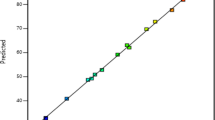Abstract
End-product conversion, low product concentration and large volumes of fermentation broth, the requirements for large bioreactors, in addition to the high cost involved in generating the steam required to distil fermentation products from the broth largely contributed to the decline in fermentative products. These considerations have motivated the study of organic extractants as a means to remove the product during fermentation and minimize downstream recovery. The aim of this study is to assess the practical applicability of liquid–liquid extraction in 2,3-butanediol fermentations. Eighteen organic solvents were screened to determine their biocompatibility, and bioavailability for their effects on Klebsiella pneumoniae growth. Candidate solvents at first were screened in shake flasks for toxicity to K. pneumoniae. Cell density and substrate consumption were used as measures of cell toxicity. The possibility of employing oleyl alcohol as an extraction solvent to enhance end product in 2,3-butanediol fermentation was evaluated. Fermentation was carried out at an initial glucose concentration of 80 g/l. Oleyl alcohol did not inhibit the growth of the fermentative organism. 2,3-Butanediol production increased from 17.9 g/l (in conventional fermentation) to 23.01 g/l (in extractive fermentation). Applying oleyl alcohol as the extraction solvent, about 68% of the total 2,3-butanediol produced was extracted.




Similar content being viewed by others
References
Shi Z, Zhang C, Chen J, Mao Z (2005) Performance evaluation of acetone–butanol continuous flash extractive fermentation process. Bioprocess Biosyst Eng 27:175–183. doi:10.1007/s00449-004-0396-7
Cheng HC, Wang FS (2007) Trade-off optimal design of a biocompatible solvent for an extractive fermentation process. Chem Eng Sci 62:4316–4324. doi:10.1016/j.ces.2007.05.010
Martik J, Rosenberg M, Schlosser S, Kristofikovi C (1995) Toxicity of organic solvents used in situ microbial fermentation. Biotechnol Tech 9(4):247–252. doi:10.1007/BF00151570
Serrano-Carreón L, Balderas-Ruíz K, Galindo E, Rito-Palomares M (2002) Production and biotransformation of 6-pentyl-α-pyrone by Trichoderma harzianumin two-phase culture systems. Appl Microbiol Biotechnol 58:170–174. doi:10.1007/s00253-001-0874-7
Eiteman MA, Gainer JL (1989) In situ extraction versus the use of an external column in fermentation. Appl Microbiol Biotechnol 30:614–618. doi:10.1007/BF00255368
Ghosh S, Swaminathan T (2003) Optimization of process variables for the extractive fermentation of 2,3-butanediol by Klebsiella oxytoca in aqueous two-phase system using response surface methodology. Chem Biochem Eng Q 17(4):319–325
Janikowski TB, Velicogna D, Punt M, Daugulis AJ (2002) Use of a two-phase partitioning bioreactor for degrading polycyclic aromatic hydrocarbons by a Sphingomonas sp. Appl Microbiol Biotechnol 59:368–376. doi:10.1007/s00253-002-1011-y
Ghanadzadeh Gilani H, Khayati G, Haghi AH (2006) Liquid–liquid equilibria of (water + 2, 3-butanediol + 2-ethyl-1-hexanol) at several temperatures. Fluid Phase Equil 247:199–204. doi:10.1016/j.fluid.2006.06.025
Heipieper HJ, Neumann G, Cornelissen S, Meinhardt F (2007) Solvent-tolerant bacteria for biotransformation in two-phase fermentation systems. Appl Microbiol Biotechnol 74:961–973. doi:10.1007/s00253-006-0833-4
MacLeod CT, Daugulis AJ (2003) Biodegradation of polycyclic aromatic hydrocarbons in a two-phase partitioning bioreactor in the presence of a bioavailable solvent. Appl Microbiol Biotechnol 62:291–296. doi:10.1007/s00253-003-1297-4
Pudge IB, Daugulis AJ, Dubois C (2003) The use of Enterobacter cloacae ATCC 43560 in the development of a two-phase partitioning bioreactor for the destruction of hexahydro-1,3,5-trinitro-1,3,5-s-triazine (RDX). J Biotechnol 100:65–75. doi:10.1016/S0168-1656(02)00229-8
Aono R, Tsukagoshi N, Miyamoto T (2001) Evaluation of the growth inhibition strength of hydrocarbon solvents against Escherichia coli and Pseudomonas putida grown in a two-liquid phase culture system consisting of a medium and organic solvent. Extremophiles 5:11–15. doi:10.1007/s007920000167
Lotter J, Botes AL, Van Dyk MS, Breytenbach J (2004) Correlation between the physicochemical properties of organic solvents and their biocompatibility toward epoxide hydrolase activity in whole-cells of a yeast, Rhodotorula sp. Biotechnol Lett 26:1191–1195. doi:10.1023/B:BILE.0000036595.09808.c2
Collins LD, Daugulis AJ (1999) Benzene/toluene/p-xylene degradation. Part I. Solvent selection and toluene degradation in a two-phase partitioning bioreactor. Appl Microbiol Biotechnol 52:354–359. doi:10.1007/s002530051531
Zigova′ J, Sturdı’k E, Vanda’k D, Schlosser S (1999) Butyric acid production by Clostridium butyricum with integrated extraction and pertraction. Process Biochem 34:835–843. doi:10.1016/S0032-9592(99)00007-2
Qin J, Xiao Z, Ma C, Xie N, Liu P, Xu P (2006) Production of 2,3-Butanediol by Klebsiella oxytoca using glucose and ammonium phosphate. Chin J Chem Eng 14(1):132–136. doi:10.1016/S1004-9541(06)60050-5
Syu MJ (2001) Biological production of 2,3-butanediol. Appl Microbiol Biotechnol 55:10–18. doi:10.1007/s002530000486
Yu EKC, Saddler JN (1983) Fed-batch approach to production of 2, 3-butanediol by Klebsiella pneumoniae grown on high substrate concentrations. Appl Environ Microbiol 46(3):630–635
Ishizaki A, Michiwaki S, Crabbe F, Kobayashi G, Sonomoto K, Yoshino S (1999) Extractive acetone–butanol–ethanol fermentation using methylated crude palm oil as extractant in batch culture of Clostridium saccharoperbutylacetonicum Nl-4 (ATCC 13564). J Biosci Bioeng 87(3):352–356. doi:10.1016/S1389-1723(99)80044-9
Wang Y, Achenie LEK (2002) Computer aided solvent design for extractive fermentation. Fluid Phase Equil 201:1–18. doi:10.1016/S0378-3812(02)00073-0
Porto TS, Monyeiro TIR, Moreira KA, Lima-Filho JL, Silva MPC, Porto ALF (2005) Liquid–liquid extraction of an extracellular alkaline protease from fermentation broth using aqueous two-phase and reversed micelles systems. World J Microbiol Biotechnol 21:655–659. doi:10.1007/s11274-004-3570-9
Author information
Authors and Affiliations
Corresponding author
Additional information
An erratum to this article can be found at http://dx.doi.org/10.1007/s10295-009-0586-z
Rights and permissions
About this article
Cite this article
Anvari, M., Khayati, G. In situ recovery of 2,3-butanediol from fermentation by liquid–liquid extraction. J Ind Microbiol Biotechnol 36, 313–317 (2009). https://doi.org/10.1007/s10295-008-0501-z
Received:
Accepted:
Published:
Issue Date:
DOI: https://doi.org/10.1007/s10295-008-0501-z




